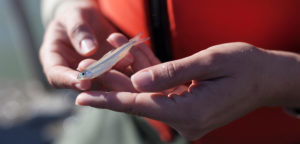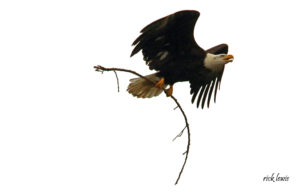While you’re heading to the polls this November, California brown pelicans will be returning to breeding grounds that range from the Channel Islands south to Mexico. From May to September, these stately birds fly as far north as British Columbia.
With its six- to seven-foot wingspan, the prehistoric-looking brown pelican seems equally at home skimming the surf at Ocean Beach or soaring in air currents high over the San Francisco Bay. Only half a century ago, pelicans came close to extinction. The pesticide DDT, then in wide use, moved up the food chain and resulted in paper-thin eggshells that devastated pelican populations. According to the San Pedro—and Cordelia—based International Bird Rescue Research Center (IBRRC) , during the 1960s, Southern California’s pelican colonies shrank by 90 percent, and in 1970, only one chick survived out of 550 nests. That same year, the brown pelican was placed on the Endangered Species List.
But since the banning of DDT in 1972, these avatars of our coastline have made a comeback. According to the Farallones Marine Sanctuary Association, nest attempts in Southern California have increased to as many as 6,000 in recent years. In December 2005, the Endangered Species Recovery Council, a small nonprofit working to recover endangered species, petitioned the U.S. Fish and Wildlife Service for delisting. Craig S. Harrison, with the Washington, D.C.—based law firm of Hunton & Williams, filed the petition. The firm’s client list includes electric utilities and coal, chemical, oil, and gas companies.
“The Endangered Species Recovery Council wants to show there’s success and integrity in the [endangered species] program, and also to free funds needed for other endangered species,” says Harrison, who also serves as vice chair for conservation of the Pacific Sea Bird Group, a society of professional seabird researchers and managers.
Other researchers caution that the pelicans aren’t out of the woods yet. The birds still face fishnets, hooks, oil spills, and domoic acid poisoning—the result of algae blooms off Southern California that don’t seem to harm the fish that eat the toxic algae, but can be fatal to marine mammals and birds that eat the fish.
“The delisting is premature. Domoic acid is having a profound effect on pelicans and sea mammals,” says IBRRC Executive Director Jay Holcomb, whose San Pedro facility treated 80 pelicans in spring 2006. He says poisoned pelicans become disoriented, fall out of the sky, and die from seizures. “No one is doing a systematic count of the birds being affected.”
The U.S. Fish and Wildlife Service is currently conducting a review to determine if delisting is warranted, according to Steve Thompson, director of Fish and Wildlife’s California/Nevada Operations Office.

.jpg)



